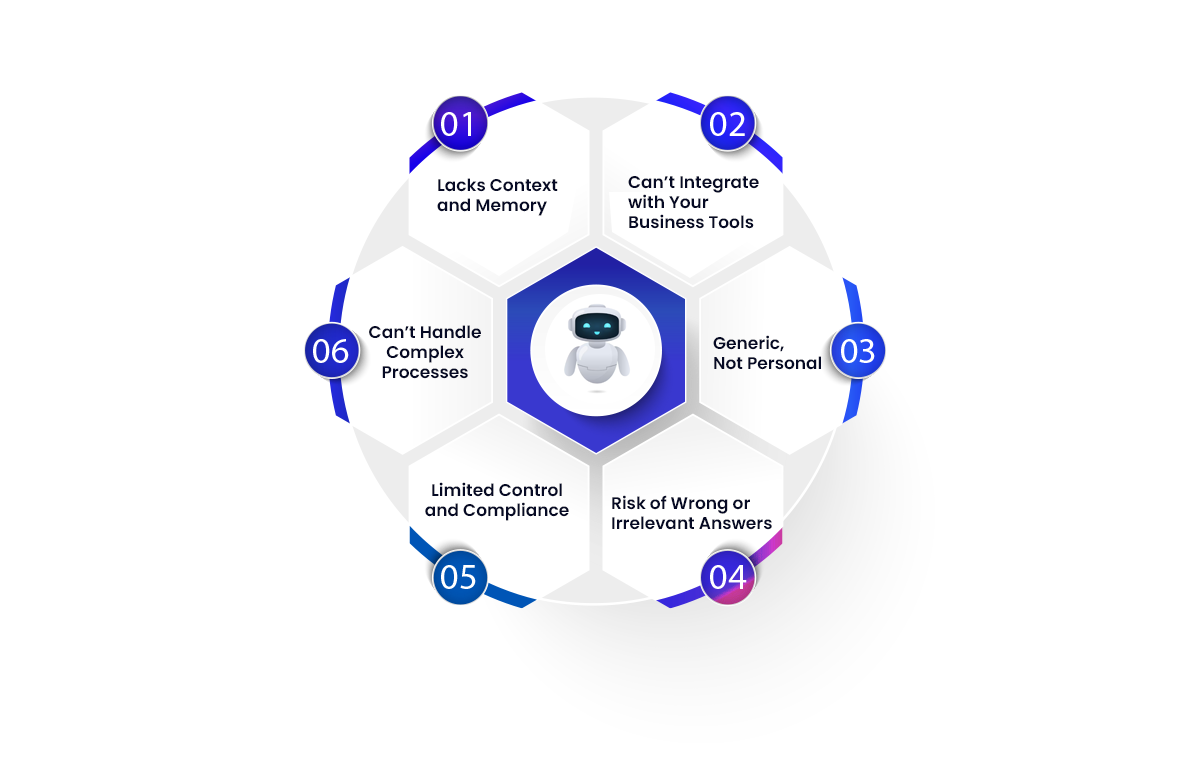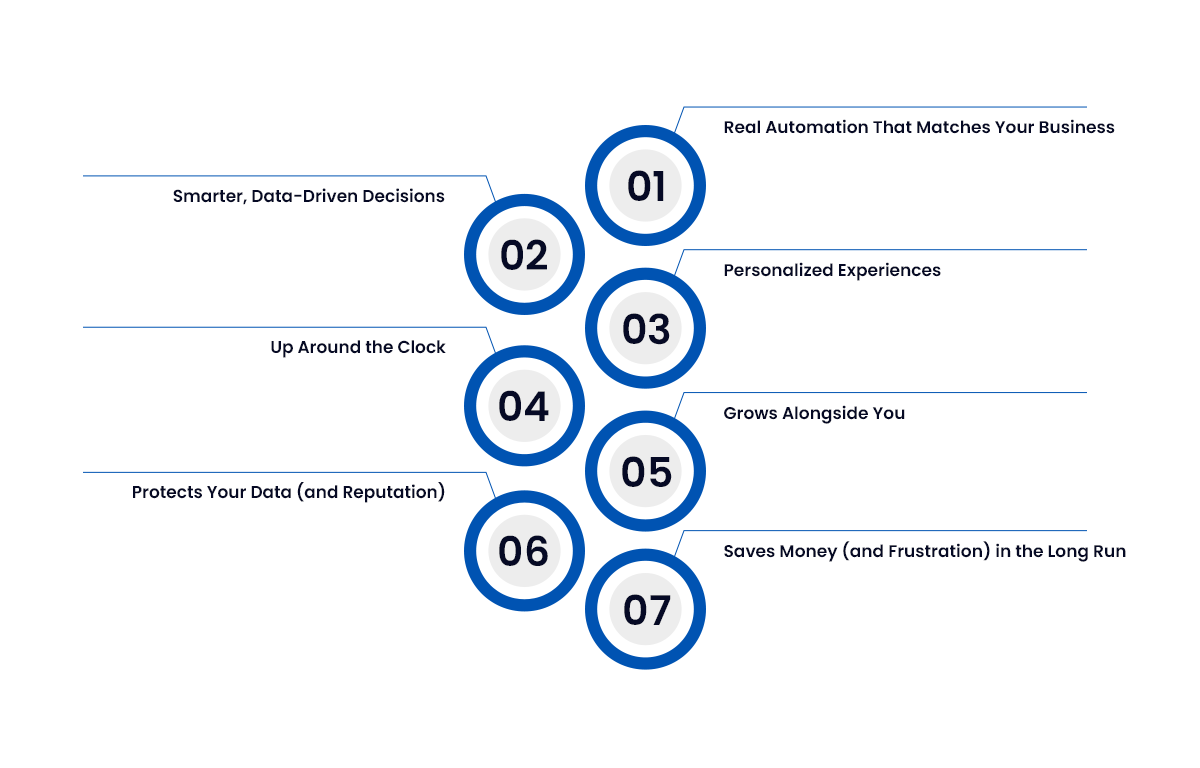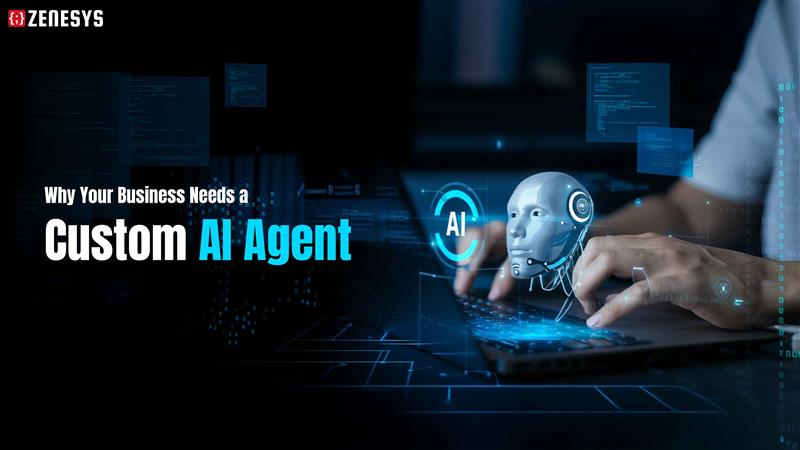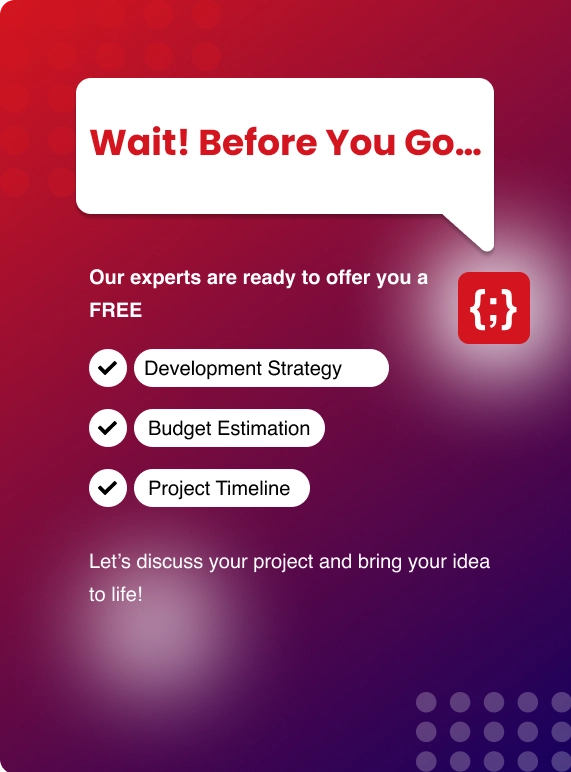You’ve probably heard about companies using artificial intelligence to get ahead. But the truth is, not every business sees big results with the same tech tools.
Studies show that while most business owners are excited about AI, 75% say the right kind of AI matters as much as the technology itself.
Here's where things go sideways. Many jump into artificial intelligence with something like ChatGPT—an excellent general chatbot, sure. But soon enough, you’re running into walls: it’s generic, it gets things wrong about your business, and it can’t manage actual tasks for you. That’s frustrating, especially if you want more than just quick answers to common questions.
So, what’s the solution?
That’s what this article is all about: why your business should think bigger than generic chatbots, and actually consider building a custom AI agent. These tailored helpers don’t just chat—they dig into your data, automate your unique tasks, play well with your tools, and make your work life easier.
Let’s break down what this really means for you and answer the questions everyone’s asking.
What Is a Custom AI Agent?
A custom AI agent isn’t just another chatbot. It’s more like a digital assistant, tuned to handle your specific business needs.
It connects to your data (think: your CRM, emails, support tickets), learns your industry lingo, “thinks” like your team, and can even do real tasks automatically.
- Instead of just answering questions, it books meetings, updates records in your database, triggers follow-ups on missed orders, screens job applicants, or handles customer refunds automatically.
It speaks in your company’s unique style, understands what matters to you, and works with your existing tools—no more copying and pasting.
It’s basically a team member who never sleeps, gets smarter with every interaction, and never forgets what happened last week.
The Limitations of ChatGPT (and Generic Chatbots)
You may be wondering: “Can’t I just use ChatGPT for my business?” It’s a common question. I’ve tested both for myself and with clients, and the experiences are very different.
Here’s where ChatGPT falls short:
.png)
- Lacks Context and Memory
ChatGPT handles conversations one-at-a-time. If a customer comes back two days later, it doesn’t remember the last chat. This can lead to repeated questions and awkward moments. - Can’t Integrate with Your Business Tools
You want your assistant to look up real-time orders in Shopify, respond to a support ticket, or automate invoice creation. ChatGPT can’t connect to your data or trigger actions—it just chats. - Generic, Not Personal
Out-of-the-box ChatGPT sounds, well, like ChatGPT. No matter how you prompt it, it doesn’t truly match your brand’s voice or deep knowledge. Customers notice. - Risk of Wrong or Irrelevant Answers
Because it’s not trained on your real data, ChatGPT sometimes makes things up, gives outdated answers, or wanders off topic. - Limited Control and Compliance
You need to ensure that confidential info stays private, or that certain topics are never discussed. This is tricky with generic chatbots that don’t know your compliance rules. - Can’t Handle Complex Processes
Approving a loan, onboarding a new employee, or checking inventory for an urgent order? These are big, multi-step tasks. ChatGPT just isn’t built for these real-world jobs.
Why Businesses Outgrow One-Size-Fits-All AI
Think about this: no two businesses are exactly the same.
You have your own workflows, special kinds of data, and favorite software tools. When you settle for a general-purpose AI, you’re forcing your team—and your customers—to squeeze into a box that doesn’t fit.
Here are some moments when businesses run into trouble:
- You want your AI to trigger specific actions in your workflow (like flagging a risky transaction or creating a follow-up task).
- Your industry has strict privacy laws or security rules—a generic bot just doesn’t cut it for compliance.
- Customers and staff send increasingly varied, complex requests that the standard bot can’t handle or route accurately.
- Your leaders want deeper insights from your own data, not some public dataset that leaves important details out.
- Your scale grows: you go from 100 support chats a month to 1,000, and every second wasted on re-explaining something is wasted money.
When Do You Need a Custom AI Agent?
I’m going to be straight with you: not every business needs a custom AI agent from day one. Sometimes, a simple chatbot is fine for answering FAQs or collecting leads. But as soon as the following situations pop up, it’s time to consider custom:
- Your repetitive tasks eat up hours daily, and you want to automate them.
- You need your assistant to pull information from your internal databases or apps.
- You want the AI to sound and think like your brand.
- You’re worried about privacy, compliance, or security issues.
- Complex workflows mean you need more than just chat—you want actual actions performed.
- You want your bot to learn from your own data (and improve over time).
- You’re expanding globally and need a multilingual AI agent that communicates naturally in any language.
Key Benefits of Custom AI Agents
- Real Automation That Matches Your Business
No more stitching together ten tools and spreadsheets. A custom agent handles your company’s unique set of tasks in just the way you want. - Smarter, Data-Driven Decisions
By connecting to your business systems, your AI agent isn’t guessing. It’s analyzing, providing insights, and alerting you to what matters—using your real numbers. - Personalized Experiences
Whether chatting with customers or supporting your team, your agent “remembers” preferences, tailors recommendations, and learns what works best.
- Up Around the Clock
Unlike human staff, your custom AI agent works weekends, holidays, and midnight shifts without extra pay or burnout. - Grows Alongside You
As your team or customer count rises, you don’t need to rush new hires—your AI assistant just keeps up with the pace. - Protects Your Data (and Reputation)
Because your custom agent is built around your requirements, it can follow your precise standards for security and compliance. - Saves Money (and Frustration) in the Long Run
Move your budget from covering avoidable mistakes and manual rework to improving your service, product, or employee happiness.
Core Differences: ChatGPT vs. Custom AI Agents
Here’s a simple breakdown to make the differences clear:
| Feature | ChatGPT | Custom AI Agent |
|---|---|---|
| Pre-trained Knowledge | General | Domain-specific |
| Access to Business Data | No | Yes |
| Task Automation | Limited | Deep Integration |
| API/CRM/ERP Integration | Manual, limited | Fully integrated |
| Memory and Context | Session-based | Persistent |
| Security & Compliance | General | Business-controlled |
| Custom Responses | Limited | Highly tuned |
How to Start Building Your Own AI Agent
-
Identify Your Biggest Business Bottlenecks
First, let’s talk pain points. Bottlenecks are those annoying points in your business that slow things down or keep repeating. Everyone’s got them—sometimes you don’t realize how much time or money they quietly steal.
Ask yourself:
- What do I dread doing every day?
- Where do errors keep cropping up?
- Which tasks eat up way too much of my team’s energy?
Jot down everything, even the stuff you think is “just part of doing business.”
Typical bottleneck examples:
- Answering the same customer questions over and over.
- Manual order entry or double-checking invoices.
- Jumping between different chats/apps to piece info together.
- Scheduling (and rescheduling) meetings all week long.
- Sifting through resumes or onboarding new hires from scratch.
-
Start with the Stuff You Wish You Didn’t Have to Do Manually
Take a good look at that list. What tasks give you “ugh, not this again” vibes? Highlight the ones that slow momentum or are just plain tedious. These are your prime candidates for automation.
For instance:
- Customer support emails that clog your inbox before breakfast.
- Creating repetitive reports in Excel every Monday.
- Copy-pasting details between different CRMs or spreadsheets.
The cool part about a custom AI agent is it doesn’t mind boring, repeat work. In fact, it craves routine—it learns and gets faster the more it does the job.
-
List the Apps and Data You Use Day-to-Day
Every business has its software stack. The more clear you are about which tools are essential, the more capable your AI agent will be. This step helps everyone understand what the agent should connect with.
Questions to ask:
- What software do you open every single day?
- Which ones hold customer records, orders, support tickets?
- Are there tools you’re forced to use for compliance?
- Where is your email, calendar, knowledge base?
Example list:
- Gmail for company email.
- Slack for team chat.
- HubSpot for customer management.
- Shopify for backend orders.
- Notion for internal docs.
- QuickBooks for invoices.
Repeat for every department or key team. The more you can map out, the better. (Plus, it makes meetings with tech partners much easier.)
-
What Tools Does Your Team Actually Live In? Which Databases Hold the Good Stuff?
Don’t just stop at the applications; think deeper. Where does all the critical info sit?
Maybe your sales team lives in Salesforce but jots secret notes in their Google Docs.
HR might officially use BambooHR, but everyone knows the onboarding checklist lives in a hidden spreadsheet.
Maybe you use a custom database built years ago—what’s in there, who updates it, and what’s plugged into it?
It’s important to get clear because this is how your agent will help. The agent isn’t magic—it has to pull, push, and reference what you’re already using.
Practical tip: Talk to your team. Ask, “If you had to find last quarter’s top customers, where would you look first?”
-
Define Your Privacy, Compliance, or Branding Needs
This part gets skipped too often, and businesses regret it later. Your AI agent should match the way you do business—especially when it comes to sensitive info and your company’s reputation.
Things to consider:
- Confidentiality: Are there certain topics, conversations, or data types that should never leave your walls or go into the cloud?
- Compliance: Are you in a field like healthcare, finance, or law with special regulations (think HIPAA, PCI, GDPR)? Even things like customer consent can change how your agent is built.
- Branding: If your business has a friendly, casual tone, your agent should too. If you’re all about professionalism (“Good morning, Ms. Smith...”), that should be the standard.
How to clarify:
- List the customer data that’s most sensitive.
- Note any legal or industry rules your business must follow.
- Decide if the agent should sound like a real person or a digital helper.
- Think about language, tone, and complexity in scripting responses.
-
Decide: Build In-House or Partner Up?
There’s no single right answer here. It depends on your budget, timeline, and technical comfort. Let’s weigh the options.
In-House
- More control. You choose what’s built, how, and can change things anytime.
- Usually needs a tech-savvy team: data engineers, software devs, maybe even your own machine learning folks.
- Takes longer up front, but long-term savings can be big.
- You’ll need to plan for updates, bug fixes, and day-to-day support.
Trusted Partner
- You can partner with an experienced AI agent development company that offers templated solutions and handles the technical details—so you can launch fast without building everything from scratch.
- Less upfront decision-making headache. Describe what you want, check in, and let them deliver.
- Usually has a monthly or annual cost. They’ll help you scale as you grow.
- You focus on what matters—your business, not troubleshooting code.
How to decide:
- Do you have people who geek out over data and software?
- Do you want everything custom, or is “90% perfect” fine?
- What’s your timeline for results? If you choose the in-house route, understanding the steps to build an AI agent will help your team navigate framework selection, architecture design, and deployment planning.
-
Start with a Small, Focused Project
Here’s where the magic starts to feel real. Rather than trying to “AI-ify” everything, pick one workflow or pain point that would make a big difference if it went away.
Examples:
- Can our agent answer the most common five customer queries automatically?
- Let’s automate follow-ups to clients who haven’t paid after 14 days.
- Set up the AI to pull data from orders and create end-of-day summary emails for the team.
-
Collect Feedback
Here’s the fun part. Once your first workflow is live, pay attention:
- Ask your team: “How does this feel?”
- Watch where the agent excels—and stumbles.
- See what customers or users point out (they’ll be honest if something is clunky).
Ready to build a custom AI agent that actually works for your business?
Zenesys helps you go beyond generic chatbots. We design AI agents that integrate with your tools, understand your workflows, and act intelligently on your behalf.
Talk to Our AI ExpertsBig Misconceptions and Common Questions
Aren’t custom AI agents too expensive?
It can look pricey at first, but factor in all the hours and mistakes saved—especially compared to bad customer experiences or high employee turnover. Even smaller businesses are finding accessible ways to start small and expand later.
Don’t I need a big IT team?
Not necessarily. Many providers offer drag-and-drop customization, or partner with you to handle the tech side. Your job is to tell them how things should work—no programming degree needed.
Will it take away jobs?
In my experience, people worry about this a lot. Most companies end up using AI to handle the boring, repetitive tasks—freeing their teams to focus on bigger, more interesting challenges that actually grow the business.
Can’t I just set up another ChatGPT or Custom GPT?
Those options have their place, but if you want an agent that talks to your databases, makes decisions, or acts on your behalf, you need to go custom.
Final Thoughts
You don’t need to replace ChatGPT. Just don’t rely on it for everything.
Think of ChatGPT like a smart assistant. Think of a custom AI agent like a trained team member who knows your company inside out.
One is general purpose. The other is purpose-built.
And when it comes to running a business, purpose-built usually wins.
If you're serious about making AI work for you, not just with you, it's time to think beyond plug-and-play tools.
Build something that actually fits.


.webp?lang=en-US&ext=.webp)

.webp?lang=en-US&ext=.webp)

